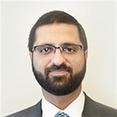QCL-Based Sensors for Chemical Kinetic Applications
Hosted By: Laser Systems Technical Group
29 November 2018 10:00 - 11:00
Eastern Time (US & Canada) (UTC -05:00)In this webinar hosted by the OSA Laser Systems Technical Group, Dr. Aamir Farooq will discuss challenges of applying optical sensors in complex, chemically reactive systems, and illustrate the sensor design and implementation process.
Design and optimization of future energy systems relies heavily on predictive models which describe the chemistry of fuel oxidation. High-fidelity chemical kinetic models for such require high-fidelity data from experiments conducted in idealized transient reactors, such as shock tubes and rapid compression machines (RCMs). Non-intrusive laser absorption diagnostics, in particular, quantum cascade lasers (QCL) in the mid-infrared wavelength region, provide unique opportunity to obtain quantitative, time-resolved species concentration and temperature data in these complex chemically reactive systems. In this webinar hosted by the OSA Laser Systems Technical Group, Dr. Aamir Farooq will talk about the challenges of applying optical sensors in such systems and illustrate the sensor design and implementation process with a couple of representative cases.
First, a pair of pulsed QCLs, targeting the fundamental vibrational band of carbon monoxide, were implemented on an RCM to measure gas temperature during the two-stage ignition process. The down-chirp phenomenon resulted in large spectral tuning (~ 3 cm-1) within a single pulse of each laser at a high pulse repetition frequency (100 kHz). The wide tuning range allowed the application of two-line thermometry technique, thus making the sensor quantitative and calibration-free.
Second, a diagnostic was developed for measuring trace concentration of CO using a pulsed QCL and an off-axis cavity implemented. The duty cycle and pulse repetition rate of the laser were optimized for increased tuning range, high chirp rate and increased line-width to achieve effective laser-cavity coupling. This enabled spectrally resolved CO line-shape measurements at high pressures (P ~10 bar) and moderate temperatures (600 - 1000 K). A gain factor of 133 and time resolution of 10 μs were demonstrated. This represents the first application of a cavity-enhanced absorption diagnostic in an RCM.
About the Presenter: Aamir Farooq,King Abdullah University of Science and Technology

Dr. Aamir Farooq is Associate Professor of Mechanical Engineering at King Abdullah University of Science and Technology (KAUST). He joined KAUST in 2010 after earning his MS and PhD degrees from Stanford University. Prof. Farooq’s research interests are in the areas of energy systems, fuel formulation and laser-based sensors. His research group focuses on high-temperature infrared spectroscopy, novel quantum-cascade laser sensors, and chemical kinetics of future fuels. He has published more than 100 archival papers in premier journals related to optics, sensors, fuels, energy and combustion. He has given several invited talks at international conferences and has organized technical sessions and workshops
